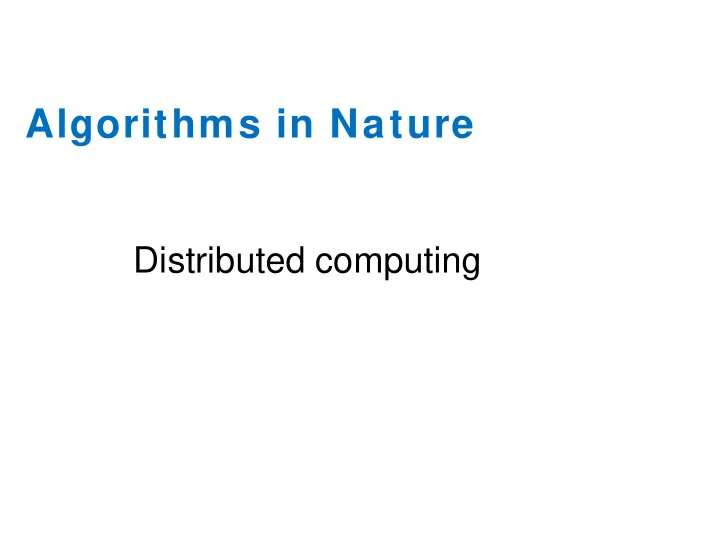

Algorithms in Nature Distributed computing
Example Distributed systems Internet ATM (bank) machines Intranets/Workgroups Computing landscape will soon consist of ubiquitous network-connected devices “The network is the computer” 2
Computers in a Distributed System Workstations: computers used by end- users to perform computing Server machines: computers which provide resources and services Mobile Devices: handheld computers connected to the system via a wireless communication link. … 3
Goals/Benefits Resource sharing Scalability Fault tolerance / Robustness Performance / Speed Parallel computing can be considered a subset of distributed computing 4
Challenges(Differences from Local Computing) Heterogeneity Latency Remote Memory vs Local Memory Synchronization Concurrent interactions the norm Partial failure Applications need to adapt gracefully in the face of partial failure 5
Challenges cont’d Security Denial of service attacks Mobile code Scalability Transparency 6
Scalability Key to scalability: decentralized algorithms and data structures No machine has complete information about the state of the system Machines make decisions based on locally available information Failure of one machine does not ruin the algorithm There is no implicit assumption that a global clock exists 7
Fundamental/Abstract Models A fundamental model captures the essential ingredients that we need to consider to understand and reason about a system’s behavior Addresses the following questions What are the main entities in the system? How do they interact? What are the characteristics that affect their collective and individual behavior? 8
Fundamental/Abstract Models Three issues to consider in models Interaction model Reflects the assumptions about the processes and the communication channels in the distributed system Failure model Distinguish between the types of failures of the processes and the communication channels Security Model Assumptions about the principals and the adversary 9
BASIC COMMUNICATION PRIMITIVE: MESSAGE PASSING Paradigm: Send message to destination Receive message from origin Nice property: can make distribution transparent, since it does not matter whether destination is at a local computer or at a remote one (except for failures). Clean framework: “Paradigms for Process Interaction in Distributed Programs,” G. R. Andrews, ACM Computing Surveys 23:1 (March 1991) pp. 49-90.
BASIC COMMUNICATION PRIMITIVE: Shared memory Paradigm: All processes use the same memory space Need to overcome concurrent access to the same location Both shared memory and message passing can be emulated by the other paradigm and so any algorithm that works for one would work for the other. However, it is easier to emulate shared memory using message passing than the other way around.
BLOCKING (SYNCHRONOUS) VS. NON-BLOCKING (ASYNCHRONOUS) COMMUNICATION For sender: Should the sender wait for the receiver to receive a message or not? For receiver: When arriving at a reception point and there is no message waiting, should the receiver wait or proceed? Blocking receive is normal (i.e., receiver waits).
Interaction Models Synchronous Distributed Systems: a system in which the following bounds are defined The time to execute each step of a process has an upper and lower bound Each message transmitted over a channel is received within a known bounded delay Each process has a local clock whose drift rate from real time has a known bound Asynchronous distributed system Each step of a process can take an arbitrary time Message delivery time is arbitrary Clock drift rates are arbitrary Some implications In a synchronous system, timeouts can be used to detect failures Impossible to detect failures or “reach agreement” in an asynchronous system 13
Interaction Models Synchronous Distributed Systems: a system in which the following bounds are defined The time to execute each step of a process has an upper and lower bound Each message transmitted over a channel is received within a Several computational problems can only known bounded delay Each process has a local clock whose drift rate from real time has be (provably) solved in a synchronous a known bound setting. However, asynchronous models are Asynchronous distributed system much more realistic. Each step of a process can take an arbitrary time Message delivery time is arbitrary Clock drift rates are arbitrary Some implications In a synchronous system, timeouts can be used to detect failures Impossible to detect failures or “reach agreement” in an asynchronous system 14
Omission and arbitrary failures Class of failure Affects Description Crash Process Process halts and remains halted. Other processes may not be able to detect this state. Omission Channel A message inserted in an outgoing message buffer never arrives at the other end’s incoming message buffer. Arbitrary Process or Process/channel exhibits arbitrary behaviour: it may (Byzantine) channel send/transmit arbitrary messages at arbitrary times, commit omissions; a process may stop or take an incorrect step. 15
Distributed applications Applications that consist of a set of processes that are distributed across a network of machines and work together as an ensemble to solve a common problem In the past, mostly “client-server” Resource management centralized at the server “Peer to Peer” computing represents a movement towards more “truly” distributed applications 16
Recommend
More recommend